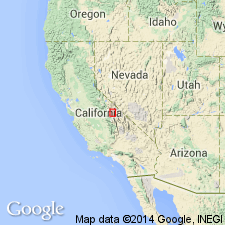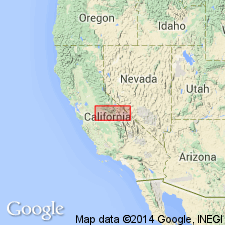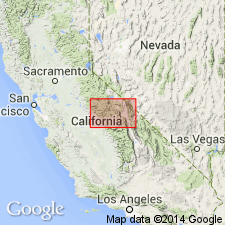
- Usage in publication:
-
- Round Valley Peak granodiorite*
- Modifications:
-
- Named
- Dominant lithology:
-
- Granodiorite
- AAPG geologic province:
-
- Sierra Nevada province
Summary:
Named for Round Valley Peak, high point along Wheeler Crest Type locality: both sides of upper Rock Creek [approx 37 deg 29'N, 118 deg 43'W, Mount Tom '15 quad (Mt. Morgan 7.5' quad), Inyo Co, CA]. Forms mass in NW corner of Mount Tom quad and adjoining 3 quads. Underlies more than 18 sq mi within Mount Tom quad; total area about 40 sq mi. Is notably equigranular and medium grained, with biotite and hornblende evenly distributed in euhedral crystals. Younger than Wheeler Crest Quartz Monzonite (new) and older than quartz monzonite similar to Cathedral Peak Granite. Tungsten Hills Quartz Monzonite believed to be younger. Is Cretaceous age.
Source: GNU records (USGS DDS-6; Menlo GNULEX).

- Usage in publication:
-
- Round Valley Peak granodiorite*
- Modifications:
-
- Age modified
- Geochronologic dating
- AAPG geologic province:
-
- Sierra Nevada province
Summary:
Shown on map. Sample of Round Valley Peak granodiorite, collected in Mount Tom quad, 1/4 mi NE Rock Creek Lake, yielded lead-alpha age of 88 Ma. Age changed to Late Cretaceous.
Source: GNU records (USGS DDS-6; Menlo GNULEX).

- Usage in publication:
-
- Round Valley Peak Granodiorite*
- Modifications:
-
- Geochronologic dating
- AAPG geologic province:
-
- Sierra Nevada province
Summary:
Sample 21 (location shown on map) of Round Valley Peak Granodiorite yielded K-Ar ages on biotite and hornblende of 85 and 72 Ma.
Source: GNU records (USGS DDS-6; Menlo GNULEX).

- Usage in publication:
-
- Round Valley Peak Granodiorite*
- Modifications:
-
- Geochronologic dating
- AAPG geologic province:
-
- Sierra Nevada province
Summary:
Sample 47 (location shown on map) of Round Valley Peak Granodiorite yielded U-Pb and Pb-Th ages of 89.1 to 82.6 Ma
Source: GNU records (USGS DDS-6; Menlo GNULEX).

- Usage in publication:
-
- Round Valley Peak Granodiorite*
- Modifications:
-
- Revised
- AAPG geologic province:
-
- Sierra Nevada province
Summary:
Included as 3rd youngest unit in John Muir Intrusive Suite (new). Forms 3 plutons that lie E of Lake Edison Granodiorite and are generally separated from it by younger Mono Creek Granite (new) and by country rocks and older granitoids. Round Valley Peak Granodiorite is strongly foliated and compositionally zoned. Intrudes Lake Edison Granodiorite (new) and Triassic Wheeler Crest Granodiorite. Is intruded by Mono Creek Granite (new). Has discordant U-Pb age of 89 Ma (Stern and others, 1981). Is Late Cretaceous age.
Source: GNU records (USGS DDS-6; Menlo GNULEX).
For more information, please contact Nancy Stamm, Geologic Names Committee Secretary.
Asterisk (*) indicates published by U.S. Geological Survey authors.
"No current usage" (†) implies that a name has been abandoned or has fallen into disuse. Former usage and, if known, replacement name given in parentheses ( ).
Slash (/) indicates name conflicts with nomenclatural guidelines (CSN, 1933; ACSN, 1961, 1970; NACSN, 1983, 2005, 2021). May be explained within brackets ([ ]).

